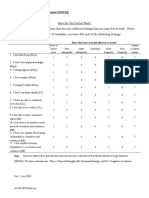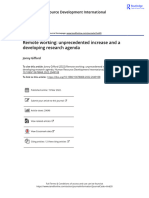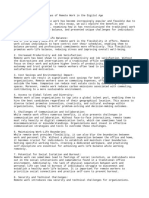Historical Context: The Evolution and Impact of Telecommuting
Historical Context: The Evolution and Impact of Telecommuting
Uploaded by
Abdelkader BadrCopyright:
Available Formats
Historical Context: The Evolution and Impact of Telecommuting
Historical Context: The Evolution and Impact of Telecommuting
Uploaded by
Abdelkader BadrOriginal Title
Copyright
Available Formats
Share this document
Did you find this document useful?
Is this content inappropriate?
Copyright:
Available Formats
Historical Context: The Evolution and Impact of Telecommuting
Historical Context: The Evolution and Impact of Telecommuting
Uploaded by
Abdelkader BadrCopyright:
Available Formats
The Evolution and Impact of Telecommuting
The concept of telecommuting, or remote work, has been around since the late 20th
century, but recent global events, particularly the COVID-19 pandemic, have
accelerated its adoption at an unprecedented scale. This article explores the evolution
of telecommuting, its benefits and challenges, and its lasting impact on the future of
work.
Historical Context
Telecommuting first gained traction in the 1970s when advancements in technology
such as personal computers and the internet began to reshape how people
communicated and conducted business. However, it primarily remained a niche practice
until the turn of the millennium, with only a small percentage of employees working
remotely. The rise of high-speed internet, collaborative software, and cloud computing
in the 2000s further facilitated remote work, making a range of jobs accessible from
virtually anywhere.
The Pandemic Catalyst
The COVID-19 pandemic in 2020 acted as a catalyst that forced many organizations to
adopt remote work models overnight. According to a survey by Stanford University,
nearly 42% of the U.S. labor force shifted to remote work during the pandemic (Barrero,
Bloom, & Davis, 2020). Companies that had previously dismissed telecommuting found
themselves rapidly adapting, and many employees reported increased productivity and
job satisfaction from home.
Benefits of Telecommuting
1. Flexibility: Remote work offers employees the flexibility to work from various
locations, reducing commute time and often allowing for a better work-life
balance.
2. Cost Savings: Both employees and employers can save money. Employees save
on commuting and meal costs, while companies can reduce overhead expenses
associated with maintaining large office spaces.
3. Access to a Global Talent Pool: Companies are no longer limited to hiring
within their geographical area. They can attract talent from across the globe,
significantly expanding their hiring options.
4. Environmental Impact: Reduced commuting can lead to lower carbon
emissions, contributing to environmental sustainability.
Challenges of Telecommuting
Despite its benefits, telecommuting presents several challenges:
1. Isolation: Remote employees may experience feelings of isolation and
disconnection from their co-workers, which can impact morale and team
cohesion.
2. Work-Life Boundary Issues: The blurring of lines between work and personal
life can lead to burnout, as employees may struggle to "switch off" after working
hours.
3. Communication Hurdles: Effective communication can be more challenging in
a remote setup, potentially leading to misunderstandings and reduced
collaboration.
4. Technology Dependence: Remote work relies heavily on technology, and
issues such as poor internet connectivity or software malfunctions can disrupt
productivity.
The Future of Work
As companies navigate the post-pandemic landscape, many are embracing hybrid work
models that combine in-office and remote work. A recent study by McKinsey found that
62% of executives plan to implement a hybrid model (McKinsey & Company, 2021). This
approach aims to capitalize on the benefits of telecommuting while addressing its
challenges.
Conclusion
The evolution of telecommuting represents a profound shift in how work is structured
and executed. While it offers numerous advantages, the challenges must be managed
to create a harmonious work environment. As organizations continue to adapt, the
future of work appears to be a flexible blend of remote and in-office arrangements,
fundamentally changing the employment landscape for years to come.
You might also like
- Citation X 750 Operating ManualDocument1,084 pagesCitation X 750 Operating ManualDan Striga100% (1)
- ShiromMelamedVigorMeasure EnglishDocument1 pageShiromMelamedVigorMeasure EnglishArturo Bueno RodríguezNo ratings yet
- Ed Sheeran Divide World Tour 2019 - 1 PDFDocument4 pagesEd Sheeran Divide World Tour 2019 - 1 PDFc mNo ratings yet
- 文件Document2 pages文件wainhuiNo ratings yet
- The Rise of Remote WorkDocument3 pagesThe Rise of Remote WorkRohitNo ratings yet
- Remote Work TrendsDocument4 pagesRemote Work TrendsMateusz AsmusNo ratings yet
- The Evolution of Remote Work and Its FutureDocument4 pagesThe Evolution of Remote Work and Its Futurecarsofpakistan92No ratings yet
- The Rise of Remote WorkDocument2 pagesThe Rise of Remote WorkManish SawaiNo ratings yet
- The Future of Remote Work: Pros and ConsDocument3 pagesThe Future of Remote Work: Pros and Consyrfgdvb27No ratings yet
- The Rise of Remote WorkDocument1 pageThe Rise of Remote Workedagheru04No ratings yet
- The Rise of Remote WorkDocument1 pageThe Rise of Remote WorkbussintekNo ratings yet
- The Rise of Remote WorkDocument3 pagesThe Rise of Remote WorkHamd FatimaNo ratings yet
- Blog 3Document2 pagesBlog 3Zaineb MatiullahNo ratings yet
- Changes in Business Models Caused by Digital Transformation and The COVID-19 Pandemic and Possibilities of Their Measurement-Case StudyDocument27 pagesChanges in Business Models Caused by Digital Transformation and The COVID-19 Pandemic and Possibilities of Their Measurement-Case StudywilliannunesbrisanetNo ratings yet
- 1Document1 page1workr285No ratings yet
- 3Document2 pages3ApriliansyahNo ratings yet
- BC-Report on Remote Work TrendsDocument24 pagesBC-Report on Remote Work Trendssidnayak48No ratings yet
- Tarigan 2023 IOP Conf. Ser. Earth Environ. Sci. 1218 012026Document7 pagesTarigan 2023 IOP Conf. Ser. Earth Environ. Sci. 1218 012026rafael tariganNo ratings yet
- Remote WorkDocument3 pagesRemote WorkGian John Rey FarroNo ratings yet
- Rise of Remote WorkDocument4 pagesRise of Remote WorkJosiah DalisayNo ratings yet
- The Evolution of Remote Work Navigating The Future of Flexible EmploymentDocument2 pagesThe Evolution of Remote Work Navigating The Future of Flexible EmploymentAntoine MNo ratings yet
- 5 TitleDocument2 pages5 TitlebradhakemanNo ratings yet
- The Rise of Remote Work and Its Impact On ProductivityDocument3 pagesThe Rise of Remote Work and Its Impact On ProductivityDak DaekNo ratings yet
- 12Document4 pages12Shirin KarwaniNo ratings yet
- 2 Advantage and DisadvantageDocument19 pages2 Advantage and DisadvantageMariam MiliNo ratings yet
- NoteDocument2 pagesNote7f2c7kd7r4No ratings yet
- The Rise of Remote WorkDocument2 pagesThe Rise of Remote WorkbarteksribdNo ratings yet
- 5ADocument2 pages5Ajaw10056No ratings yet
- The Rise of Remote Work-Redefining The Modern WorkplaceDocument2 pagesThe Rise of Remote Work-Redefining The Modern Workplacekjsingh01No ratings yet
- Title 2Document2 pagesTitle 2pratheekshasnair002No ratings yet
- Tele CommutingDocument8 pagesTele CommutingTourist PakistanNo ratings yet
- Whats Next For Remote Work FDocument13 pagesWhats Next For Remote Work FEdgar Perea LópezNo ratings yet
- The Future of Remote Work PDFDocument2 pagesThe Future of Remote Work PDFkosiwop kaudatNo ratings yet
- The Remote RevolutionDocument1 pageThe Remote Revolutionkamami2020No ratings yet
- What's Next For Remote Work: An Analysis of 2,000 Tasks, 800 Jobs, and Nine CountriesDocument5 pagesWhat's Next For Remote Work: An Analysis of 2,000 Tasks, 800 Jobs, and Nine CountriesFlorencia Oviedo AguirreNo ratings yet
- Article 3Document1 pageArticle 3enrqarts18No ratings yet
- The Rise of Remote Work: Transforming The Modern WorkplaceDocument1 pageThe Rise of Remote Work: Transforming The Modern WorkplaceDiego VargasNo ratings yet
- Ai 4Document1 pageAi 4mikeveb973No ratings yet
- The Future of WorkDocument3 pagesThe Future of Workanh phương hoàngNo ratings yet
- FilesDocument3 pagesFilesAnn maria JollyNo ratings yet
- Soc of DevDocument10 pagesSoc of DevNACHIKETH REDDY 2030726No ratings yet
- Work-From-Home Is Here To Stay - Call For Flexibility in Post-Pandemic Work PoliciesDocument12 pagesWork-From-Home Is Here To Stay - Call For Flexibility in Post-Pandemic Work PoliciesparhusipmikhaelNo ratings yet
- The Benefits and Challenges of Remote WorkDocument1 pageThe Benefits and Challenges of Remote Workrahullal11122No ratings yet
- Challenges and Opportunities of Remotely Working From HomeDocument10 pagesChallenges and Opportunities of Remotely Working From Homekhanhphamngoc1716No ratings yet
- Hybrid Model For Remote Work Practice in The Post Pandemic Era Prospects and ChallengesDocument7 pagesHybrid Model For Remote Work Practice in The Post Pandemic Era Prospects and ChallengesphaaixNo ratings yet
- Am Ethical Argument Essay Final DraftDocument9 pagesAm Ethical Argument Essay Final Draftapi-653628343100% (1)
- Remote Working Unprecedented Increase and A Developing Research AgendaDocument10 pagesRemote Working Unprecedented Increase and A Developing Research AgendafoenemNo ratings yet
- The Future of Remote WorkDocument5 pagesThe Future of Remote WorkNoorNo ratings yet
- Remote Work - WikipediaDocument22 pagesRemote Work - WikipediaJuan joseNo ratings yet
- Management Informations SystemDocument7 pagesManagement Informations SystemSahriar EmonNo ratings yet
- TRS6 Test 2 WritingDocument3 pagesTRS6 Test 2 WritingQuốc AnhNo ratings yet
- TGJ V16 N2 Summer 2020 DS ArticleDocument5 pagesTGJ V16 N2 Summer 2020 DS ArticleSam PatNo ratings yet
- The Benefits and Challenges of Remote WorkDocument2 pagesThe Benefits and Challenges of Remote WorkerkanaptiNo ratings yet
- ISYS2109_Group12_Team4Document18 pagesISYS2109_Group12_Team4thucdoanthaidoanNo ratings yet
- Covid and Remote WorkDocument19 pagesCovid and Remote WorkVirág VadaNo ratings yet
- Persuasive research assignmentDocument4 pagesPersuasive research assignmentsingh04231No ratings yet
- Remote Working Covid Mukhopadhyay 1904 PDFDocument5 pagesRemote Working Covid Mukhopadhyay 1904 PDFsafa haddadNo ratings yet
- The New Normals of Work A Framework For Understanding Responses To Disruptions Created by New Futures of WorkDocument25 pagesThe New Normals of Work A Framework For Understanding Responses To Disruptions Created by New Futures of WorkKing AyomideNo ratings yet
- Adapted Lifestyles: Work: 14 MinutesDocument15 pagesAdapted Lifestyles: Work: 14 MinutesAcevagner_StonedAceFrehleyNo ratings yet
- Material 1Document17 pagesMaterial 1prabinachudal2017No ratings yet
- PanelDocument32 pagesPanelkishore_bulli6666No ratings yet
- Iso 15713Document22 pagesIso 15713ceydabilginayNo ratings yet
- How To Avoid Varus Stem in THRDocument6 pagesHow To Avoid Varus Stem in THRPoliceNo ratings yet
- Operation of PumpsDocument25 pagesOperation of PumpsPrajval ChauhanNo ratings yet
- Antisol®-WB: Product Data SheetDocument2 pagesAntisol®-WB: Product Data Sheetkamran abbasiNo ratings yet
- I. Multiple Choice. Read Carefully and Choose The Correct AnswerDocument5 pagesI. Multiple Choice. Read Carefully and Choose The Correct AnswerRonalyn CajudoNo ratings yet
- Earth Resources and Engineering Lab CO PO Justification 21CV34 LabDocument9 pagesEarth Resources and Engineering Lab CO PO Justification 21CV34 Labarun_68No ratings yet
- NTPC Assistant Engineer Syllabus 2022Document3 pagesNTPC Assistant Engineer Syllabus 2022Karan DhawaleNo ratings yet
- TDG 0018, 0019 & 0020 Rev - 0Document10 pagesTDG 0018, 0019 & 0020 Rev - 0Preeti goswamiNo ratings yet
- Unit - 1 & 2 PDFDocument50 pagesUnit - 1 & 2 PDFSharmila ArunNo ratings yet
- Technology) NC Iii: GradeDocument29 pagesTechnology) NC Iii: GradeAntonio D. MontemayorNo ratings yet
- Investors' Protection in India: Regulatory Framework and Investors' Rights, Obligations & GrievancesDocument33 pagesInvestors' Protection in India: Regulatory Framework and Investors' Rights, Obligations & GrievancesHarshSuryavanshiNo ratings yet
- Music of The Neo-Classical PeriodDocument21 pagesMusic of The Neo-Classical Periodkukuhpaige100% (1)
- Accounting Diffusion Theory Approach (P3+4) - Dàn ÝDocument4 pagesAccounting Diffusion Theory Approach (P3+4) - Dàn ÝQuang Minh NguyễnNo ratings yet
- Sueduresearchjournal, Journal Manager, 01Document7 pagesSueduresearchjournal, Journal Manager, 01Fabio Andrés Bernal rincónNo ratings yet
- Using Dialogue in Teaching GrammarDocument2 pagesUsing Dialogue in Teaching GrammarLailyNo ratings yet
- Protecting Your Child From LeadDocument2 pagesProtecting Your Child From LeadKevinSeanHeldNo ratings yet
- Non-Concomitant Strabismus 2Document60 pagesNon-Concomitant Strabismus 2Ijeoma Okpalla100% (2)
- Bonavera Count LyseDocument5 pagesBonavera Count LyseTho Fie LeeNo ratings yet
- Chapter_____-16___ADJECTIVE_20240715124457Document16 pagesChapter_____-16___ADJECTIVE_20240715124457Rakesh JaiswalNo ratings yet
- B. by Car B. Under The Window C. at 2 P.M. C. A Big Round Box A. 18Document7 pagesB. by Car B. Under The Window C. at 2 P.M. C. A Big Round Box A. 18Minhh PhúcNo ratings yet
- Hentai Sim Brothel Strategy Guide PDFDocument2 pagesHentai Sim Brothel Strategy Guide PDFAnanda GautamaNo ratings yet
- PDFDocument16 pagesPDFBernardo Salinas TeránNo ratings yet
- Tech Gr9 Eng TG 2017ED Lowres PDFDocument181 pagesTech Gr9 Eng TG 2017ED Lowres PDFHumaira KhanNo ratings yet
- Sustrans Handbook For Cycle-Friendly Design 11-04-14Document36 pagesSustrans Handbook For Cycle-Friendly Design 11-04-14J Alberto FernándezNo ratings yet
- Scientist Magazine ArticleDocument2 pagesScientist Magazine Articleindiedump777No ratings yet
- NCC DPR Format - 090324Document7 pagesNCC DPR Format - 090324Ranjan KumarNo ratings yet

























































































